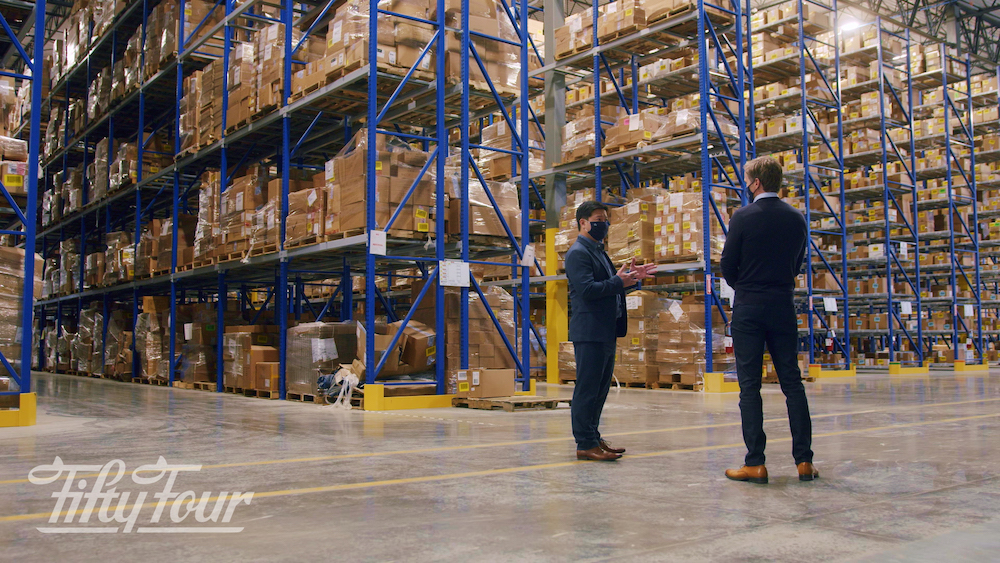
Warehouse Management Systems (WMS) can be Santa’s secret weapon for effectively and efficiently managing the enormous task of delivering gifts worldwide. More and more warehouse and distribution center operations are relying on warehouse management systems to remain competitive in the fast-changing industry of supply chain management and materials handling. In the midst of this peak holiday season, it is imperative that goods and services are delivered when expected and in good condition. Customer demand can be met with tools and solutions that enhance productivity and efficiency as well as providing cost savings at year-end. After all, Santa does keep a naughty list. So here are some ways that WMS can help Santa and his elves deliver goods on time and with zero errors.
A warehouse management system is a software solution that plays a pivotal role in the efficient management of warehouse operations and inventory flow. Designed to streamline the movement, storage, and tracking of goods within a warehouse, a warehouse management system provides visibility and control over critical warehouse processes, from receiving and storing to picking, packing, and shipping. By automating these tasks and integrating them with other operational systems, a warehouse management system helps companies optimize their space, reduce operational costs, improve accuracy, and enhance customer satisfaction. In today’s fast-paced, data-driven supply chain environments, a robust warehouse management system is essential for companies aiming to maintain competitive advantage and meet the rising demands for speed and precision in order fulfillment.
Why WMS Is So Important
There are several important components in a warehouse management solution that can be integrated with equipment and processes within the warehouse or distribution center. One of the most important is inventory control. Warehouse management systems will track all inventory in real-time, providing visibility into stock levels, storage locations and workflow across the warehouse floor. Integrating order management in the solution will manage the fulfillment process from order receipt to shipment, ensuring efficient and accurate order processing. Optimizing the warehouse layout is extremely important in that it ensures that items are stored in optimal locations to improve picking efficiency and maximize space utilization. The cost of labor is a key factor in improving the bottom line. A labor management solution coordinates tasks for warehouse workers, helping manage labor costs and productivity. Keeping track of the KPIs helps in the decision-making for the short and long term. Warehouse management systems will provide real-time data and analytics, providing valuable insights for planning, allowing businesses to forecast demand, plan inventory, and optimize operations.

WMS Offers Key Benefits
Improved Accuracy in Inventory Management
A comprehensive warehouse management system minimizes human errors by using barcode/RFID scanning, real-time tracking, and automated stock counts. This leads to more accurate inventory records and reduces the risk of stock-outs and overstocking. An order management component manages the fulfillment process from order to receipt to shipment, ensuring efficient and accurate order processing. Any time inventory management can be streamlined to enhance the productivity and efficiency of the operational processes, a cost-savings is expected.
Enhanced Operational Efficiency
A warehouse management system optimizes picking, packing, and shipping workflows, which reduces the time required for order processing. With optimized layout and picking paths, it minimizes unnecessary movement and ensures faster fulfillment. A highly-effective functional integrated system can prioritize inventory delivery and shipping timelines. A real-time visibility into route planning can be achieved with a GPS and routing software component. The repetitive tasks of finding the inventory and moving it to the shipping dock can be streamlined with a solution to minimize the movement across the warehouse floor. Labor management is an important function of a warehouse management system in that it can coordinate tasks for warehouse workers which will assist in labor cost management and productivity.
Better Space Utilization
Warehouse management systems offer a component that can recommend efficient storage solutions, like dynamic slotting, where items are stored based on demand, seasonality, or picking frequency. This maximizes available space, reducing the need for additional storage facilities. A good warehouse management system will help with growth and scalability. It can support increasing order volumes and more complex workflows, allowing for a scalable solution that adapts to evolving operational needs.
Improved Customer Satisfaction
In order to keep customers happy and improve loyalty for return business, it is proven that warehouse management systems can provide faster, more accurate order processing. An improved process leads to quicker delivery and fewer mistakes. In the current business environment, it is important to remain competitive and improve warehouse or distribution center efficiency while cutting costs of repetitive tasks. Keeping the workers productive and working effectively can minimize overruns of labor costs.
Data-Driven Decision Making
Warehouse management systems provide comprehensive data of inventory levels, order fulfillment rates, employee productivity thereby allowing management to make informed, data-driven decisions to improve their operations continuously. Real-time data and analytics provide valuable insights for decision-making that allows warehouse management to forecast demand, plan inventory and optimize operations. With automated systems, the guesswork is taken out of the equation of order fulfillment. Workers can be free of repetitive tasks that may prove unproductive in the long run. With all the information readily available, informed decisions can be made.
Simplified Returns Process
A warehouse management system can streamline reverse logistics, helping manage returns quickly and tracking items back into inventory, which saves time and preserves the product value. With automated tracking components integrated into the process, errors can be reduced.
Cost Savings
By optimizing space, reducing labor hours, and minimizing errors, a warehouse management system significantly cuts down on costs related to warehousing and fulfillment. It can also reduce costly returns by improving order accuracy. Eliminating some repetitive tasks will assist with labor management and costs.
Summary
A warehouse management system is an essential tool for modern warehousing and distribution centers, providing the infrastructure to manage and optimize operations, lower costs, and drive better service for customers.
54 Intralogistics Can Help Santa Deliver
54 Intralogistics offers integrated solutions for warehouse management systems that will maximize the efficiency and profitability of your warehouse or distribution center operations. The 54 Intralogistics team will review and analyze your warehouse logistics, layout, machinery, technology, workers and specifications. You can then expect valid suggestions to optimize processes from the loading and delivery dock to the packing and shipping area. Let us assist you in determining which solutions will work best for your warehouse operation. After all, in this busy season, we want to ensure that Santa delivers on time.
